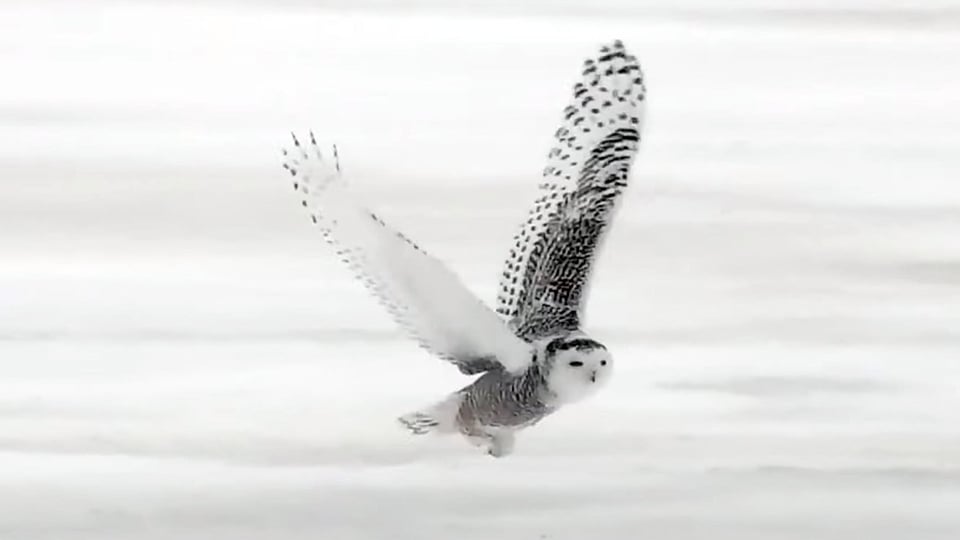By Karla Bloem, Executive Director, International Owl Center
Owls are a varied group of birds. Some species are normally resident on their territories year-round (like Great Horned Owls and Barred Owls), some species are more or less migratory (like Northern Saw-whet Owls), some are nomadic, wandering around and settling where the food is (like Short-eared Owls), and some are irruptive, where a bunch show up in random years (like Snowy Owls and Great Gray Owls.)
Why are Snowy Owls showing up on the Flyway Cam?

January 8, 2022: A Snowy Owl on the Flyway
Snowy Owl breeding is driven by lemming populations on the tundra. These chunky rodents make up the bulk of their diet on their breeding grounds. If there aren’t many lemmings, owls won’t breed at all, or will raise few young. When there are lots of lemmings, lots of young Snowy Owls are produced. When lots of young Snowy Owls are produced we may see an irruption (thankfully not an ‘eruption’ like a volcano) into places where we don’t see them every winter.
Many (but not all) of the owls that come south are in pretty good shape. They look for places that resemble their tundra home: flat and treeless. This often translates into airports, flat fields, or even river ice. (Snowy Owls sometimes spend winters in the tundra on sea ice hunting waterfowl.) Snowy Owls and airplanes don’t go well together, so many times they are trapped and relocated away from airports.
Age, Sex, and Snowy Owls near La Crosse

January 6, 2022: Multiple Snowy Owls on the Flyway!
I showed photos and videos of some of the Snowy Owls on the Flyway Cam and Bryce Prairie to Roar Solheim, a Snowy Owl biologist from Norway. He has literally written the book on sexing and aging Snowy Owls (I wouldn’t even try after reading it!!) There are at least a couple of juvenile females, and one image he believes may be an older female.
JF Therrien, who studies Snowy Owls on their breeding grounds in Nunavut, Canada, recently gave a webinar as part of the International Owl Center’s free Virtual Owl Expert Speaker Series. He noted that there are some places where Snowy Owls regularly winter. These locations normally have owls every winter, and they have a higher percentage of adult birds. Places like the La Crosse area, where we don’t regularly get lots of owls, will have a much higher percentage of hatch-year owls when they do show up.
Why is that Snowy Owl just sitting there? Is it OK?

January 5, 2022: A Snowy Owl on the Flyway
When they live on the tundra, during the summer they have 24-hour daylight, so some people mistakenly think that Snowy Owls are diurnal (day-active). Snowy Owls also have 24-hour dark when they spend the winter up there. Basically the owls can be flexible, but their preference is to be active hunting from dusk to dawn and snooze during the day when they are in the lower 48 states. That being said, owls don’t conk out for eight hours straight like us and then are awake the rest of the time. They doze off and on any time of day, but just have certain times they are more likely to be active. But generally you’ll just see them sitting around all day, often on the ground or a low perch, and then at dusk they get active and fly off to go hunting.
Are Snowy Owls faithful to their wintering sites?
Thanks to satellite tracking, banding and tagging, researchers have discovered that Snowy Owls can be faithful to their wintering sites more than to their breeding sites. Dan Zazelenchuk, a Snowy Owl bander from Saskatchewan, caught the same owl 13 years after it was first banded in the same general location. Norman Smith, who traps owls at Logan Airport in Boston, has also banded Snowy Owls many years after first banding them at the airport.
On rare occasions a Snowy Owl may oversummer, not bothering to go back north for the summer. These owls aren’t necessarily sick or injured. Then they go back to the tundra at the end of the next winter, like they are “supposed” to. (Owls aren’t good at reading the books we write about them, so they don’t always follow the rules we set up for them.)
How are Snowy Owls Doing?
They seem to be declining. Denver Holt, founder of the Owl Research Institute, has been studying them on their breeding grounds in northern Alaska for 30 years. He is seeing a decline in nesting in recent years, while JF still sees nesting every year in Nunavut.
Often people get so excited about seeing a Snowy Owl (or other owl) their common sense leaves their head. To be good owl hosts, it is important to observe owls respectfully. This involves learning to interpret their body language. You can find lots of information about this here:
https://www.internationalowlcenter.org/respectful_observation.html
Resources and Links
To learn a lot more about Snowy Owls from the experts, you can watch a presentation by Roar Solheim:
or this presentation by JF Therrien:
Learn more about the tracking of Snowy Owls by Project Snowstorm:
https://www.projectsnowstorm.org/
Denver Holt of the Owl Research Institute has been studying Snowy Owls on their breeding grounds for 30 years. Check out their Snowy Owl info page:
https://www.owlresearchinstitute.org/snowy-owl
A thousand thanks to Executive Director Karla Bloem for writing a guest blog on Snowy Owls! If you haven’t visited her website, check it out: https://www.internationalowlcenter.org/. The Center isn’t far from Decorah and is well-worth the trip! We have a tiny bit more about the owls we’ve been seeing here: https://www.raptorresource.org/2022/01/07/two-snowy-owls-on-the-flyway/.
 The Raptor Resource Project
The Raptor Resource Project The Raptor Resource Project
The Raptor Resource Project